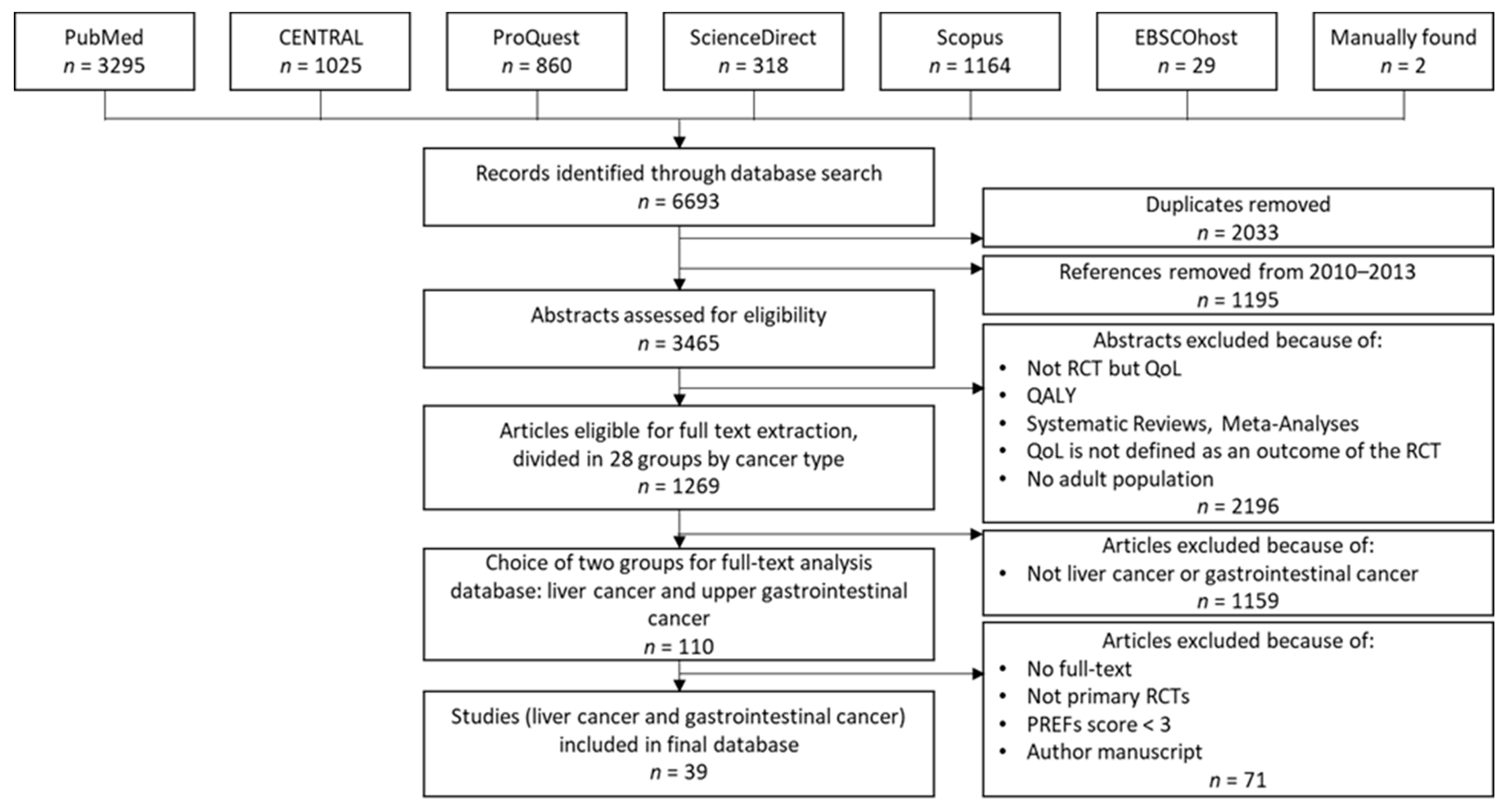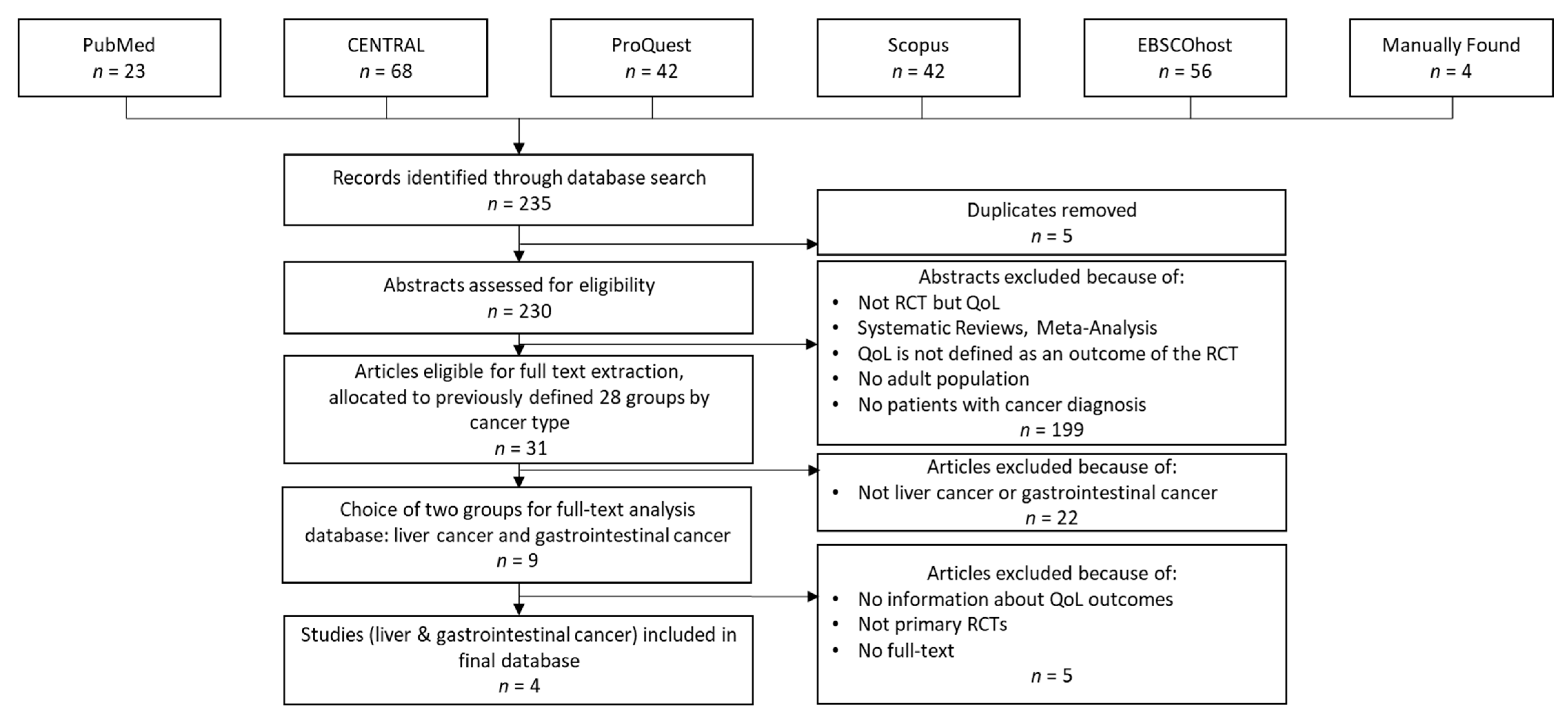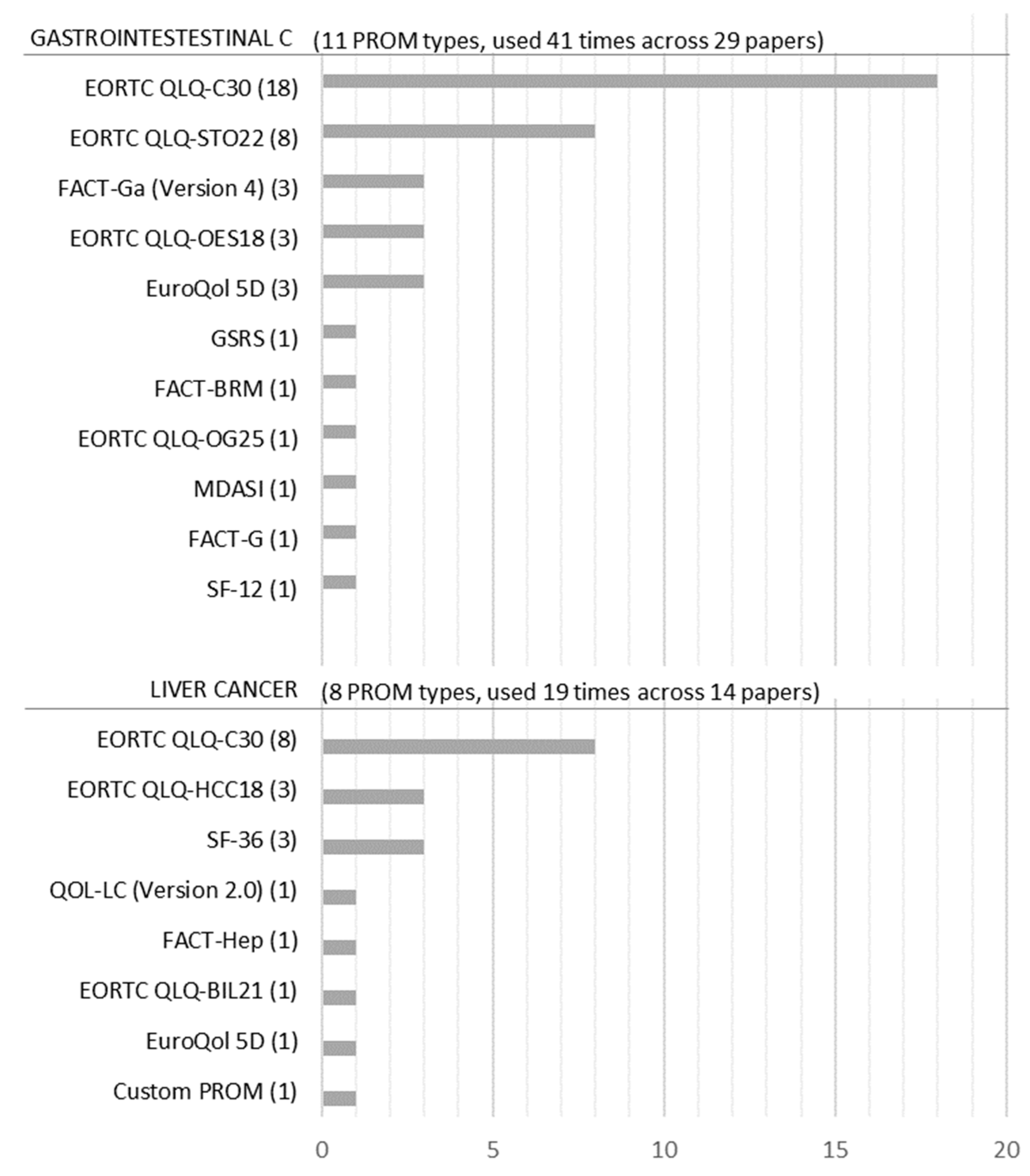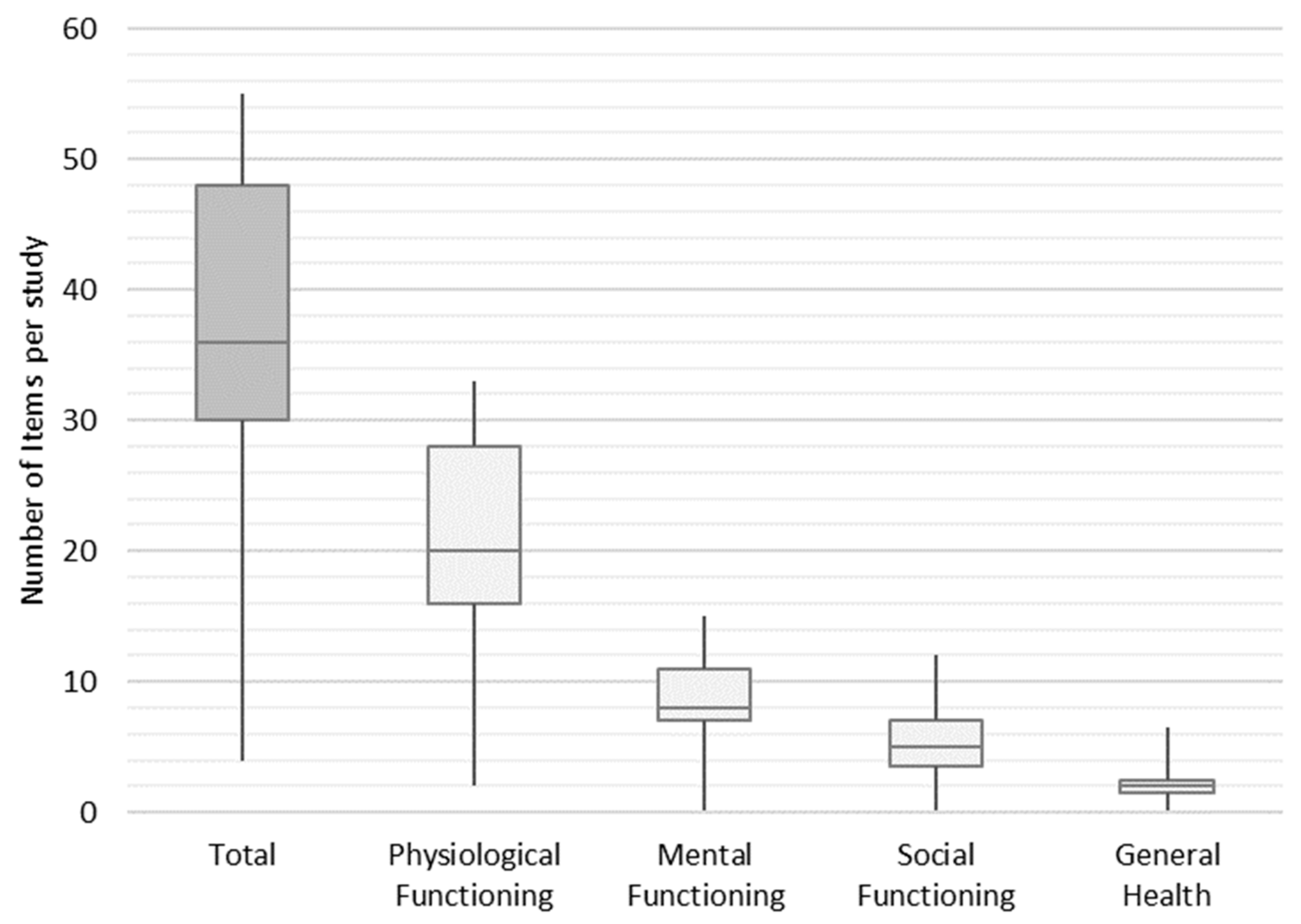Patient-Reported Outcome Measures in Liver and Gastrointestinal Cancer Randomized Controlled Trials
Abstract
1. Introduction
2. Methods
2.1. Study Eligibility
2.2. Study Identification and Search Strategy
2.3. Study Selection
2.4. Synthesis Methods
3. Results
3.1. Study Selection 2010–2020
3.2. Results of Syntheses
3.3. Distribution of Publications by Cancer Type
3.4. Frequency of PROM Types Used in Liver and Gastrointestinal Cancer Studies
3.5. Number of PROMs per Study
3.6. Set of Items
3.7. Frequency of Functional Groups
4. Discussion
4.1. Summary of Evidence
4.2. Limitations
4.3. Future Research
5. Conclusions
Supplementary Materials
Author Contributions
Funding
Institutional Review Board Statement
Informed Consent Statement
Data Availability Statement
Conflicts of Interest
Abbreviations
| HRQoL | Health-Related Quality of Life; |
| PRO | Patient Reported Outcome; |
| PROM | Patient Reported Outcome Measure; |
| QoL | Quality of Life; |
| RCT | Randomized Controlled Trial; |
| WHO | World Health Organization. |
References
- Persad, G.; Wertheimer, A.; Emanuel, E.J. Principles for allocation of scarce medical interventions. Lancet 2009, 373, 423–431. [Google Scholar] [CrossRef] [PubMed]
- Hariton, E.; Locascio, J.J. Randomised controlled trials—The gold standard for effectiveness research: Study design: Randomised controlled trials. BJOG Int. J. Obstet. Gynaecol. 2018, 125, 1716. [Google Scholar] [CrossRef]
- Sushko, K.; Menezes, H.T.; Strachan, P.; Butt, M.; Sherifali, D. Self-management education among women with pre-existing diabetes in pregnancy: A scoping review. Int. J. Nurs. Stud. 2021, 117, 103883. [Google Scholar] [CrossRef]
- Graupner, C.; Kimman, M.L.; Mul, S.; Slok, A.H.M.; Claessens, D.; Kleijnen, J.; Dirksen, C.D.; Breukink, S.O. Patient outcomes, patient experiences and process indicators associated with the routine use of patient-reported outcome measures (PROMs) in cancer care: A systematic review. Support. Care Cancer Off. J. Multinatl. Assoc. Support. Care Cancer 2021, 29, 573–593. [Google Scholar] [CrossRef]
- WHO. Constitution of the World Health Organization. Am. J. Public Health Nation’s Health 1946, 36, 1315–1323. [Google Scholar] [CrossRef] [PubMed]
- U.S. Department of Health and Human Services FDA Center for Drug Evaluation and Research; U.S. Department of Health and Human Services FDA Center for Biologics Evaluation and Research; U.S. Department of Health and Human Services FDA Center for Devices and Radiological Health. Guidance for industry: Patient-reported outcome measures: Use in medical product development to support labeling claims: Draft guidance. Health Qual. Life Outcomes 2006, 4, 97. [Google Scholar]
- Montazeri, A. Health-related quality of life in breast cancer patients: A bibliographic review of the literature from 1974 to 2007. J. Exp. Clin. Cancer Res. 2008, 27, 32. [Google Scholar] [CrossRef] [PubMed]
- Coates, A.S.; Hürny, C.; Peterson, H.F.; Bernhard, J.; Castiglione-Gertsch, M.; Gelber, R.D.; Goldhirsch, A.; International Breast Cancer Study Group. Quality-of-life scores predict outcome in metastatic but not early breast cancer. J. Clin. Oncol. Off. J. Am. Soc. Clin. Oncol. 2000, 18, 3768–3774. [Google Scholar] [CrossRef]
- Weingärtner, V.; Dargatz, N.; Weber, C.; Mueller, D.; Stock, S.; Voltz, R.; Gaertner, J. Patient reported outcomes in randomized controlled cancer trials in advanced disease: A structured literature review. Expert Rev. Clin. Pharmacol. 2016, 9, 821–829. [Google Scholar] [CrossRef]
- Robert-Koch-Institut. Krebs in Deutschland-Leber. Available online: https://www.krebsdaten.de/Krebs/DE/Content/Publikationen/Krebs_in_Deutschland/kid_2021/kid_2021_c22_leber.pdf?__blob=publicationFile (accessed on 24 June 2023).
- Altekruse, S.F.; McGlynn, K.A.; Reichman, M.E. Hepatocellular carcinoma incidence, mortality, and survival trends in the United States from 1975 to 2005. J. Clin. Oncol. Off. J. Am. Soc. Clin. Oncol. 2009, 27, 1485–1491. [Google Scholar] [CrossRef]
- Schönfeld, I.; Kraywinkel, K. Epidemiologie des hepatozellulären Karzinoms in Deutschland. Onkologe 2018, 24, 653–658. [Google Scholar] [CrossRef]
- Forner, A.; Llovet, J.M.; Bruix, J. Hepatocellular carcinoma. Lancet 2012, 379, 1245–1255. [Google Scholar] [CrossRef] [PubMed]
- Geoghegan, J.G.; Scheele, J. Treatment of colorectal liver metastases. Br. J. Surg. 1999, 86, 158–169. [Google Scholar] [CrossRef] [PubMed]
- Gallego, G.; Bridges, J.F.P.; Flynn, T.; Blauvelt, B.M.; Niessen, L.W. Using best-worst scaling in horizon scanning for hepatocellular carcinoma technologies. Int. J. Technol. Assess. Health Care 2012, 28, 339–346. [Google Scholar] [CrossRef]
- Lo, S.H.; Sharma, R.; Costentin, C.E.; Aggio, D.; Shergill, S.; Colaone, F.; Brennan, V.K.; Straccia, V.A.; Agirrezabal, I.; Lloyd, A.J. Patient preferences for advanced hepatocellular carcinoma treatment: A multicountry stated preference study. Future Oncol. 2021, 17, 4275–4287. [Google Scholar] [CrossRef]
- Page, M.J.; McKenzie, J.E.; Bossuyt, P.M.; Boutron, I.; Hoffmann, T.C.; Mulrow, C.D.; Shamseer, L.; Tetzlaff, J.M.; Akl, E.A.; Brennan, S.E.; et al. The PRISMA 2020 statement: An updated guideline for reporting systematic reviews. BMJ (Clin. Res. Ed.) 2021, 372, n71. [Google Scholar]
- Rammant, E.; Ost, P.; Swimberghe, M.; Vanderstraeten, B.; Lumen, N.; Decaestecker, K.; Bultijnck, R.; de Meerleer, G.; Sarrazyn, C.; Colman, R.; et al. Patienten- versus arztberichtete Ergebnisse von Prostatakrebspatienten nach hypofraktionierter Radiotherapie innerhalb einer randomisierten kontrollierten Studie. Strahlenther Onkol. 2019, 195, 393–401. [Google Scholar] [CrossRef]
- Scocco, P.; Fantoni, G.; Caon, F. Role of depressive and cognitive status in self-reported evaluation of quality of life in older people: Comparing proxy and physician perspectives. Age Ageing 2006, 35, 166–171. [Google Scholar] [CrossRef] [PubMed]
- Joy, S.M.; Little, E.; Maruthur, N.M.; Purnell, T.S.; Bridges, J.F.P. Patient preferences for the treatment of type 2 diabetes: A scoping review. PharmacoEconomics 2013, 31, 877–892. [Google Scholar] [CrossRef]
- Higgins, J.P.T. (Ed.) Cochrane Handbook for Systematic Reviews of Interventions, 2nd ed.; Cochrane Book Series; Wiley-Blackwell: Hoboken, NJ, USA, 2020. [Google Scholar]
- Richardson, W.S.; Wilson, M.C.; Nishikawa, J.; Hayward, R.S. The well-built clinical question: A key to evidence-based decisions. ACP J. Club 1995, 123, A12. [Google Scholar] [CrossRef]
- Zhu, M.-W.; Yang, X.; Xiu, D.-R.; Yang, Y.; Li, G.-X.; Hu, W.-G.; Wang, Z.-G.; Cui, H.-Y.; Wei, J.-M. Effect of oral nutritional supplementation on the post-discharge nutritional status and quality of life of gastrointestinal cancer patients after surgery: A multi-center study. Asia Pac. J. Clin. Nutr. 2019, 28, 450–456. [Google Scholar] [PubMed]
- Murphy, M.; Hollinghurst, S.; Salisbury, C. Identification, description and appraisal of generic PROMs for primary care: A systematic review. BMC Fam. Pract. 2018, 19, 41. [Google Scholar] [CrossRef] [PubMed]
- Brucker, P.S.; Yost, K.; Cashy, J.; Webster, K.; Cella, D. General population and cancer patient norms for the Functional Assessment of Cancer Therapy-General (FACT-G). Eval. Health Prof. 2005, 28, 192–211. [Google Scholar] [CrossRef] [PubMed]
- Cleeland, C.S.; Mendoza, T.R.; Wang, X.S.; Chou, C.; Harle, M.T.; Morrissey, M.; Engstrom, M.C. Assessing symptom distress in cancer patients. Cancer 2000, 89, 1634–1646. [Google Scholar] [CrossRef]
- Fayers, P.; Bottomley, A. Quality of life research within the EORTC-the EORTC QLQ-C30. European Organisation for Research and Treatment of Cancer. Eur. J. Cancer 2002, 38 (Suppl. 4), S125–S133. [Google Scholar]
- EORTC. EORTC QLQ-C30 (Version 3). Available online: https://www.eortc.org/app/uploads/sites/2/2018/08/Specimen-QLQ-C30-English.pdf (accessed on 24 June 2023).
- Lamping, D.L. Measuring health-related quality of life in venous disease: Practical and scientific considerations. Angiology 1997, 48, 51–57. [Google Scholar] [CrossRef]
- Spitzer, W.O. State of science 1986: Quality of life and functional status as target variables for research. J. Chronic Dis. 1987, 40, 465–471. [Google Scholar] [CrossRef]
- Brundage, M.; Bass, B.; Davidson, J.; Queenan, J.; Bezjak, A.; Ringash, J.; Wilkinson, A.; Feldman-Stewart, D. Patterns of reporting health-related quality of life outcomes in randomized clinical trials: Implications for clinicians and quality of life researchers. Qual. Life Res. Int. J. Qual. Life Asp. Treat. Care Rehabil. 2011, 20, 653–664. [Google Scholar] [CrossRef]





| Type of Cancer | Quantity of Papers |
|---|---|
| Liver cancer | 14 |
| Colorectal liver metastases | 3 |
| Hepatocellular carcinoma | 6 |
| Cholangiocarcinoma | 1 |
| Liver cancer | 4 |
| Gastrointestinal cancer | 29 |
| Esophageal cancer | 3 |
| Esophageal or gastric cancer | 3 |
| Gastric and colorectal cancer | 1 |
| Gastric cancer | 17 |
| Gastrointestinal cancer | 3 |
| Upper gastrointestinal cancer | 2 |
| Total | 43 |
| Type of Cancer | No. of Studies | ||
|---|---|---|---|
| One PROM | Two PROMs | Three PROMs | |
| Colorectal liver metastases | 3 | ||
| Liver cancer | 6 | 5 | |
| Gastrointestinal cancer | 18 | 10 | 1 |
| Total No. of studies | 27 | 15 | 1 |
| PROM Type | No. of Items | Physiological Functioning | Mental Functioning | Social Functioning | General Health |
|---|---|---|---|---|---|
| Custom PROM | 4 | 50% | 50% | 0% | 0% |
| EORTC QLQ-BIL21 | 12 | 67% | 25% | 0% | 8% |
| EORTC QLQ-C30 (V.3) | 30 | 53% | 23% | 17% | 7% |
| EORTC QLQ-HCC18 | 18 | 67% | 22% | 11% | 0% |
| EORTC QLQ-0ES18 | 13 | 92% | 0% | 8% | 0% |
| EORTC QLQ-OG25 | 25 | 64% | 28% | 8% | 0% |
| EORTC QLQ-STO22 | 22 | 77% | 18% | 5% | 0% |
| EuroQol 5D | 5 | 60% | 20% | 20% | 0% |
| FACT-BRM (Version 4) | 40 | 35% | 38% | 23% | 5% |
| FACT-G | 27 | 30% | 30% | 33% | 7% |
| FACT-Ga (Version 4) | 46 | 46% | 24% | 26% | 4% |
| FACT-Hep | 45 | 53% | 22% | 20% | 4% |
| GSRS | 15 | 100% | 0% | 0% | 0% |
| MDASI | 19 | 53% | 26% | 11% | 11% |
| Qol-LC v2.0 | 22 | 41% | 32% | 23% | 5% |
| SF-12 | 12 | 42% | 33% | 17% | 8% |
| SF-36 | 36 | 56% | 22% | 6% | 17% |
| Weighted Average | 391 | 54% | 25% | 16% | 5% |
Disclaimer/Publisher’s Note: The statements, opinions and data contained in all publications are solely those of the individual author(s) and contributor(s) and not of MDPI and/or the editor(s). MDPI and/or the editor(s) disclaim responsibility for any injury to people or property resulting from any ideas, methods, instructions or products referred to in the content. |
© 2023 by the authors. Licensee MDPI, Basel, Switzerland. This article is an open access article distributed under the terms and conditions of the Creative Commons Attribution (CC BY) license (https://creativecommons.org/licenses/by/4.0/).
Share and Cite
Winkelmann, C.; Mezentseva, A.; Vogt, B.; Neumann, T. Patient-Reported Outcome Measures in Liver and Gastrointestinal Cancer Randomized Controlled Trials. Int. J. Environ. Res. Public Health 2023, 20, 6293. https://doi.org/10.3390/ijerph20136293
Winkelmann C, Mezentseva A, Vogt B, Neumann T. Patient-Reported Outcome Measures in Liver and Gastrointestinal Cancer Randomized Controlled Trials. International Journal of Environmental Research and Public Health. 2023; 20(13):6293. https://doi.org/10.3390/ijerph20136293
Chicago/Turabian StyleWinkelmann, Carolin, Anna Mezentseva, Bodo Vogt, and Thomas Neumann. 2023. "Patient-Reported Outcome Measures in Liver and Gastrointestinal Cancer Randomized Controlled Trials" International Journal of Environmental Research and Public Health 20, no. 13: 6293. https://doi.org/10.3390/ijerph20136293
APA StyleWinkelmann, C., Mezentseva, A., Vogt, B., & Neumann, T. (2023). Patient-Reported Outcome Measures in Liver and Gastrointestinal Cancer Randomized Controlled Trials. International Journal of Environmental Research and Public Health, 20(13), 6293. https://doi.org/10.3390/ijerph20136293





